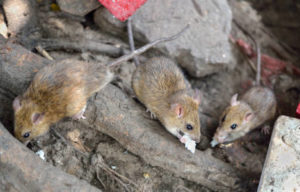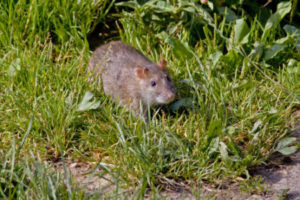Rats outside; thinking Outside of the box
By Zachary Ciras on August 5, 2022.
In the last several years, reports of rats in suburban neighborhoods has certainly increased. That’s no surprise, as the overall rat population is decidedly on the rise. Global rat populations are increasing as well. Some experts have marked major increasing since around 2005, and despite dips in their population since then due to a variety of stressors, rats have an amazing capacity to recover and replace any populations loss. During an online meeting with Newton, MA residents, Dr. Bobby Corrigan has estimated that rat populations have increased 15%-35% depending on city, city conditions, and city age. Without scientific papers published, reported complaints and hearsay are the only indicators we have to rely on for numbers, but it seems safe to say there are more rats in more residential areas these days. Rat exterminators, such as we at Colonial Pest Control, have been engaged at increased levels regarding the issue. See Lots of rats!
Is there any one factor producing these results, and is there any one solution to solve the rodent problem in areas like Newton, MA, Worcester, MA, and the suburbs around Boston, Lowell, and Lynn? Of course the answer to both is no; there is no one thing to blame, nor one thing to count on for a reliable remedy. The answer is more wholistic and requires individuals and groups working together with a common goal aimed at unrelentingly. Sound impossible? We can all start with our own homes and yards.
The Northeastern Megalopolis
The Northeastern Megalopolis, also known as the Acela Corridor or the Northeast Corridor, is the area stretching from Boston to Washington DC along the coast and encompassing many large cities. The population of the areas is well over 50 million people, and the economic output is the largest in the world. In our area, the Greater Boston area including Worcester, MA, Providence, RI, Manchester, NH, and all of the cities and suburbs between is home to over 8 million. This corridor is also one of the richest corridors in terms of commensal rodent activity. Wherever there’s people, there will be rats and mice.
Commensal Rodents are rodents (from the Latin “rodens” meaning one who gnaws) who share (“com“) our tables (“mensalis“). Commensal rodents such as the Norway rat (Rattus norvegicus) and the House Mouse (Muscus domesticus) are dependent on human activity to thrive. They are incredibly resources and adaptive, so they would be able to adapt to a more wild environment without human activity, but what makes them so prolific is their ability to take advantage of human behavior. With that in mind, more human activity tends to translate into more commensal rodent activity. Mouse Removal and extermination has changed in light of increased numbers, but still involves the primary features of exclusion to reduce or eliminate the reintroduction of rodents into a structure, using baits and traps to eliminate the existing population, and offering education to property owners, tenants, and city officials on the best course of rodent prevention long-term. Rat extermination follows a similar track, but what should one do about rats not necessarily inside the structure (at least not yet) but carousing in your neighborhood outside?
Rat Problems

Brown Rat (Rattus norvegicus) .
Are rodents operating on the outside of a structure really an issue? One answer is to suggest that it’s only a matter of time before they make their way inside. This may or may not be true depending on the structural rat proofing measures you have taken. The truth is that rats dig, they burrow, and they cause issues due to this alone. Especially in a city such as Newton, MA, where many of the old city sewers have hundreds of rat colonies within them, digging can damage pipes, sewers, and underground electrical and communication wires to name a few. The structural integrity of walkways and sidewalks, streets, and grounds may also become compromised. Rats also carry a number of diseases and pathogens which they share to other animals and human alike whenever they are around. Their dropping and urine are at the very least unsightly and odorous. Rats and mice are invasive species, in fact. These rodents are not native to New England or anywhere near here. The best estimations have the originating from Asia and shipped around the world via trade and travel. Rats do significant ecological damage as well, damaging native vegetation and disrupting and displacing other animals. Countries like New Zealand who home a multitude of native species not evolved to deal with ground dwelling predation know this pain too well. Ground nesting birds, plants, and other life have seen great harm due to the introduction of rats, stouts, and the like. New Zealand has instituted an aggressive program to rid the island nation of rats et al by 2050.
Beyond the catastrophic threats, rats can damage your home garden, small farm, landscape, and make your own backyard uncomfortable to be in. They carry a major “ick” factor which has been earned through the millennia. Problems only get worse should they enter your structure. Property damage, fire hazards, and other risks are a result of a rat infestation.
What’s the Cause
The cause of rodent infestations, especially rat infestations, is incalculably complex. Rats travel through river beds and comprise hundreds of colonies through cities and towns. Resources like food and shelter are the only requirements for a population to expand, and rats are expert at finding and exploiting these resources. The overall number of rats is dependent on these factors, but many of our customers are quick to blame things such as the pandemic or construction. Are they right to?
Construction is a common occurrence when there’s an increase in rodent, especially, rat activity. however, the construction is not the CAUSE of the population increase, it certainly causes disruptions in their colonies and changes their behavior, open driving them out from underground dens and into more visible locations, inclusion in and around structures. See STARVING RATS ARE MOVING INTO NEW AREAS!
The same can be said about changes which resulted from the pandemic. The restaurant dumpsters generations of rats would be accustomed to feeding from were not as reliable. Human traffic changed. People worked from home, had take out dinners instead of visiting the city, and started their own gardens. Many people have been raising their own chickens in their back yards. All of these factors can also be sited as contributing factors of an increase in suburban rat expansion. Composting vegetable waste is a great mission, but keep in mind that it must be done with care and attention to detail. Compost bins must be turned, fungus and bacteria encouraged, and kept free of waste more attractive to rats like meat scraps and bones. In the winter, compost bins also produce a lot of desirable heat, so if rats are in the neighborhood, they will take advantage and burrow nearby.
Yard clutter, overgrowth, and junk piled up in one property of a neighborhood can contribute to the entire areas succumbing to a rat infestation. Harborage for rat nesting should be reduced, and city officials are sometimes required to interject in order to stem off or resolve a rodent situation.
What’s the Solution

Brown Norway rat
Rat extermination is not as simple as placing black boxes containing rodenticide around your property and crossing your fingers. There are problems at times with rats’ reluctance to consume these unfamiliar baits, or even worse, if associations have been ,are to dissuade rats from trusting the bait in the boxes. Concerns of predatory raptors are also a factor when considering control. Birds of prey may be susceptible to secondary poisoning from eating rodent who have eaten rodenticides, especially second generation anticoagulant rodenticides, or SGARs. SGARs contain a lethal does within one feeding, but still take several days to achieve full effect. That excess rodenticide can be stored in the body of the target pest, then transferred to raptors feeding on the rodents. Mammalian secondary poisoning is less concerning, as birds systems make them especially vulnerable to the rodenticide. When our expert technicians assess and plan for rat extermination on a site, we consider this among all factors and weigh the costs and benefits seriously. Alternate consumable control methods are sometimes utilized, but are not as reliable as exterior rodent baiting.
Trapping poses similar risks and benefits. If done correctly, trapping quickly and safely eliminates rats one at a time in a targeted area. If not executed properly, non-target animals are exposed to trapping.
Burrow treatments with meal baits, tracking powders, and CO2 via dry ice or engine generated sources are also great tools to have in the tool box for a rat exterminator. Ultimately, a combination of control measures, mechanical controls, physical barriers, and sanitation and cooperation all need to work together to achieve the aim.
Cooperation is Key
Cooperation between the Pest Control firm needs to be maintained. The technicians and homeowners must have an open line of communication and be able to speak honestly about the situation. Rat control and removal is not simple work, and it often requires multiple ongoing site visits from the pest control operator. In addition to the homeowner and pest control technician cooperation, the neighborhood or city may need to be involved. Dr. Corrigan suggested to these interested parties in Newton to organize a “Rat Free Newton” group to inspect for conducive conditions, address potential issues with residents, and involve pest control companies and city officials whenever needed.
Rat extermination is achievable, but only by working together with common goals and a shared understanding of what would be required. Some of the first steps we recommend are to stop feeding the birds, remove or improve housing for urban/suburban farm animals such as chickens, and fix damaged fences and decks. We do recommend cleaning up any clutter or yard waste which may become harborage for rodents, and invest in quality garbage cans and waste stream resources. Our expert technicians have the knowledge to assess rat situations and advise on corrective actions to reduce and eliminate rats from your home and property. Sometimes, it just tales thinking outside of the box.
Listen to our Podcast Rats in New England Homes (Podcast)
Download our FREE E-Book Identifying and Removing Mice and Rats from Your Home